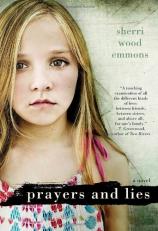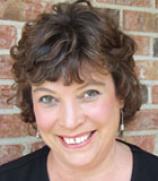Interview: January 28, 2011
First-time author Sherri Wood Emmons is captivating readers with PRAYERS AND LIES, her haunting debut that follows a small-town girl’s journey into adulthood --- and her gradual discovery of several unimaginable secrets that, once disclosed, threaten to shatter lives, destroy faith, and break bonds that she thought would last forever. In this interview with Bookreporter.com’s Bronwyn Miller, Emmons talks about the childhood memories that inspired the book, going into detail about her desire to write a novel set in West Virginia and the character who eventually became Reana Mae. She also discusses the challenge of writing from a young girl’s perspective, reflects on the difficulty of addressing child abuse as a mother, and muses on the coming-of-age novel that, when she was a teenager, made her feel more like an author and less like an odd duck.
Bookreporter.com: What was the genesis of PRAYERS AND LIES?
Sherri Wood Emmons: I think of PRAYERS AND LIES as an almost accidental novel. I didn’t set out to write fiction; I just wanted to write down some memories of times my family had spent in West Virginia. But the more I wrote, the more I worried that what I was writing wasn’t “true.” And I kept seeing a little girl at the edges of the story --- a child mostly unwanted by her parents and pretty much left to raise herself. In my mind, her name was Reana Mae. Eventually, I gave up trying to write what was “real” and just let Reana Mae tell her story.
BRC: Your family spent time on the Coal River. Did you always intend to write something about this place?
SWE: We spent summers there when I was a kid, and it was a place I genuinely loved. We had lots of family there, and the times I spent on the river were some of the happiest of my childhood. I didn’t think of writing about it until I had my own children. I wanted them to have a feel for the place that was so important to me as a child.
BRC: PRAYERS AND LIES features many strong female characters, including Helen, Belle, Araminta and Bethany, to name just a few. Did you base any of them on people you know?
SWE: Belle started out based on my Great Aunt Lillian, but she grew into her own character pretty quickly. And there are certainly aspects of Helen that remind me of my mom. But there are a lot of strong women in my family. Both of my grandmothers were single moms during the Great Depression. One of them went to work in a bakery to support her family; the other was a maid in a hotel. I learned a lot about hard work, faith and family from them.
BRC: How did you decide to tell the story from Bethany’s point of view instead of Reana Mae’s? What are the challenges you faced writing from a tween and then a teen perspective?
SWE: Once I decided to let the book go where it wanted to go, I started writing in the third person. But it just didn’t work. Then I tried telling the story from Reana Mae’s point of view. But Reana has so many secrets, and I didn’t want them to come out all at once. Writing from Bethany’s perspective lets the reader discover the truths as she does.
The biggest challenge of writing from a young girl’s perspective was keeping the voice her own and using only the language she would use. A lot of times, I had to go back and rewrite passages because they sounded too “adult” to be coming from Bethany.
BRC: The relationship between Caleb and Reana Mae is shocking. As a mother, was this difficult for you to write?
SWE: It was hard, especially because my own daughter was about Reana’s age when I was writing those scenes. Sometimes after I wrote, I would go sit in her room and just watch her sleep and thank God that she was safe.
What I struggled with the most, though, was trying to show that, while the relationship is definitely shocking and inappropriate, Reana Mae and Caleb both get something positive from it. They love each other in a weird kind of way, and they take care of each other as best they can. For both of them, the relationship provides warmth and acceptance --- things neither of them find in their own nuclear families.
BRC: Is it necessary for a writer not to judge her characters? And with which characters would that prove most difficult?
SWE: I think it’s important not to judge the characters as you’re writing them. Sometimes, that’s easier than others. I knew from the start that Tracy was mentally ill, so it was easy to sympathize with her. And Caleb started out a pure villain, but then all these mitigating factors popped up. His parents have both abandoned him, so he doesn’t really have a safe place in the world.
I think the hardest character was Jolene. I wrote an entire section about her childhood that I eventually had to delete because there was no way Bethany could have known about it all. That’s one of the difficulties of writing in the first person, I guess. But that back-story gave me Jolene’s motivations, and I hope they help to soften her a bit.
BRC: PRAYERS AND LIES covers so many relationships --- cousins, sisters, mothers and daughters, friends. Did you intend to write about all the different kinds of bonds and their effects on us? Do you feel a responsibility to your characters?
SWE: I didn’t start out with the aim of writing about so many relationships. I come from a big family, and I think that experience is reflected in the story. Family is the crux of everything, really --- who we are, how we deal with life, and the decisions we make are all rooted in our family of origin. I think most of us spend time as adults trying to work through all our family stuff, because it’s such a huge part of who we are. And in the end, it’s those family bonds that give us our grounding.
I do feel a responsibility to my characters. It’s funny how real they became to me while I was writing, almost like members of my own family. I wanted very much to give them their due and let them tell their stories in their own ways. Sometimes that meant putting my own plans for them aside and letting them dictate what happened, and that wasn’t always easy. But in the end, I think it worked.
BRC: The relationship between Bethany and Reana Mae is a complicated one: “Her story and mine got so tangled up together, sometimes it felt like I was just watching from the outside, like she was the one living. Sometimes, I hated her for that. But mostly, I loved her.” Is writing about relationships between females --- sisters, cousins, friends --- easier or harder than writing about relationships between men?
SWE: For me, it’s easier to write about females. I grew up with four sisters, so maybe that’s a given. I also think women’s relationships are often more complicated than men’s. Maybe that’s because, for so long, women didn’t have any real power outside of the household, so they spent a lot of time figuring out the relationships and power structures within the household. And they had to rely on one another for support and help. Or maybe it’s just because I’m a woman.
BRC: Who do you think has the most complex relationship in PRAYERS AND LIES?
SWE: I think the relationship between Reana Mae and Caleb has the most layers. On one level, it’s a classic case of child abuse. Caleb is an adult, and of course he’s also Reana’s uncle. The sexual relationship is absolutely wrong. On another level, however, Caleb is good to and for Reana Mae. He is the first adult in her life (outside of Helen, who is only around in the summer) to give her attention and affection. They form a kind of family unit in the complete absence of responsible parents.
BRC: The prologue reads: “The Bible says that the sins of the father are visited upon the sons to the seventh generation. But I believe it’s the daughters who bear the brunt of most family sins. At least that’s so in my family.” Do you believe this to be true, or just in this family’s case?
SWE: I do believe that women and girls historically have borne the brunt of family problems. Again, because women traditionally did not have economic power of their own, they had to stay in bad and, sometimes, even abusive relationships. Men, on the other hand, were free to walk away.
BRC: Did you know where you intended to go with the story when you started? Do you start with an outline or work more organically, seeing where the characters take you?
SWE: I didn’t have any idea where the story was going at first. And even after I had a vague plan, the characters kept doing things I didn’t expect them to do and taking the story in different directions. The lynchpin was always the tension between Reana Mae and Tracy, but even with that story line, several things happened that I didn’t expect.
BRC: What would you like readers to take away from PRAYERS AND LIES?
SWE: I hope they find that the story is ultimately hopeful. Bad things happen in the book. Bad things happen in life. In the end, what gets us through is love --- the love of our families and our friends. Sometimes it’s a matter of just holding on tight and refusing to let go.
BRC: We can see this book working well for a book club discussion, and in fact we have the discussion guide postedhere. What parts of the book do you think will bring out lively discussions?
SWE: The relationship between Caleb and Reana Mae should spark some discussion. Tracy’s behavior, and the way Helen and Jimmy deal with it (or don’t), is another area ripe for conversation. The casual racism Belle displays has sparked some conversation in our household. And Bethany’s decision to have a baby in the end also caused some debate in my family.
BRC: Do you remember any favorite coming-of-age novels that inspired you to become a writer?
SWE: My favorite book growing up was LITTLE WOMEN, and I definitely wanted to be like Jo. She came from a family full of sisters, like I did. And she was always the “odd duck” in the family, like I was. And she was a writer, which I dearly wanted to be.
BRC: What’s next for you?
SWE: Right now, I’m working on a story about a little girl whose mother drifts in and out of her life as she grows up, and the effect that has on her sense of self and security. Ultimately, it’s a book about family and forgiveness.
And I’ve made a start on a new story that’s set in West Virginia in the 1930s and ’40s. It’s my first attempt with a male protagonist, so that should be interesting.
• Click here now to buy this book from Amazon.




